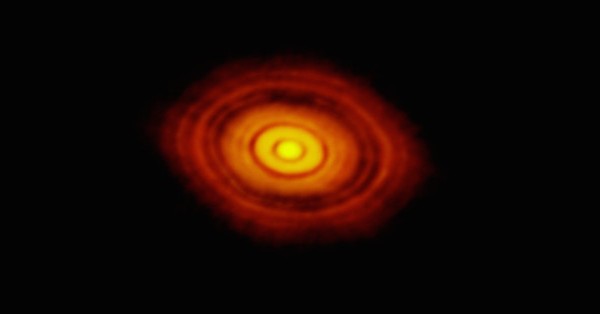
Why do poets and astronomers gaze upon the stars? Is it because, in contemplating the infinite, humans understand the insignificance we imagine an ant might feel on being poked with a stick by a chimp? Or, as Walt Whitman wrote in his poem “On The Beach At Night Alone,” because we realize that, “A vast similitude interlocks all, / All spheres, grown, ungrown, small, large, suns, moons, planets / All distances of place however wide, / All distances of time / All inanimate forms … .”
I ponder the vast similitude as I gaze upon an exquisite image of HL Tauri, an infant star located 450 light-years from Earth in the constellation of Taurus. The million-year-old sun-like star has been revealed in fine detail by ALMA, the Atacama Large Millimeter/submillimeter Array, a huge telescope made out of 66 high-precision, movable antennae positioned on the Chajnantor plateau in northern Chile.
HL Tauri, as the image shows, consists of a young star surrounded by a series of bright, concentric rings separated by dark gaps. The rings—constituting the “protoplanetary disc”—were formed from a cocoon of dust and gas that once surrounded the newborn star. Dust particles within the disc, slamming into each other, clump together to create pebble-sized objects and, eventually, asteroids and embryonic planets called planetesimals. As they orbit the star, these proto-planets sweep up debris, sculpting paths—the dark patches between the rings—through the dust cloud.
In visible light, the star is obscured by a shroud of dust, but ALMA operates at longer millimeter/submillimeter wavelengths of light—between infrared and radio waves—that shine brightly in dark, cold regions where new stars are being born. As explained in a video issued by the European Southern Observatory (ESO)—which operates ALMA with international collaborators—the antennae were spaced at their near-widest extent, about nine and a half miles apart. Even at that separation, ALMA functions as one antenna, and its resolution is finer than that ofany Earth or space observatory.
“This one image alone will revolutionize theories of planet formation,” says Catherine Vlahakis, an ALMA Deputy Program Scientist quoted in an ESO press release. That is because, at no more than a million years old, HL Tauri is assumed to be too young to be surrounded by a disc filled with newly forming planets. “Most current theories of planet formation expect that the sticking of dust grains to form planetesimals, and the collection of planetesimals to form planetary bodies, will occur in later stages of the disk lifetime,” ALMA team scientist Laura Perez of National Radio Astronomy Observatory in Socorro, New Mexico, explained to me via email. But HL Tauri shows signs of youth, she said, including jets of material streaming outward that will subside as the star contracts over time.
Investigating the genesis of proto-planets can also help us understand similar processes in our own solar system, the time of Earth’s formation more than four billion years ago, Perez wrote. “We will learn about our own formation by looking at ‘twins’ of the solar system as well as understanding the physics behind planet formation in all these different systems.”
That similarity inspires more Whitmanesque wonder than feelings of ant-like insignificance. “We have been waiting for ALMA’s amazing capabilities to deliver really cool science, and I was in awe by looking at the very first image … and realizing that this is just the beginning,” Perez wrote. “There is so much more to explore and so much more to learn. What this image really encompass[es] is the future that ALMA will have, and the future is bright.”

